PV_3 - Another house in the country
-
this is another house I designed for the same place in the wine making district in my state in southern brasil. the site is very steep (a 17m drop from the highest corner to the street level). since sloping roofs are a kind of fetish in the area I tried my hand at it, although my solution is not exactly conventional.
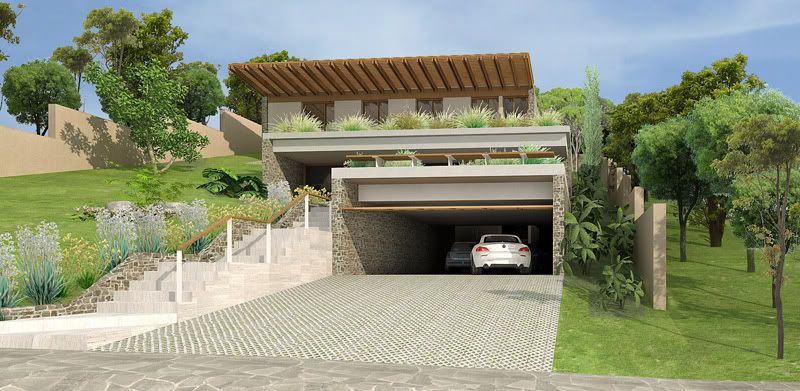
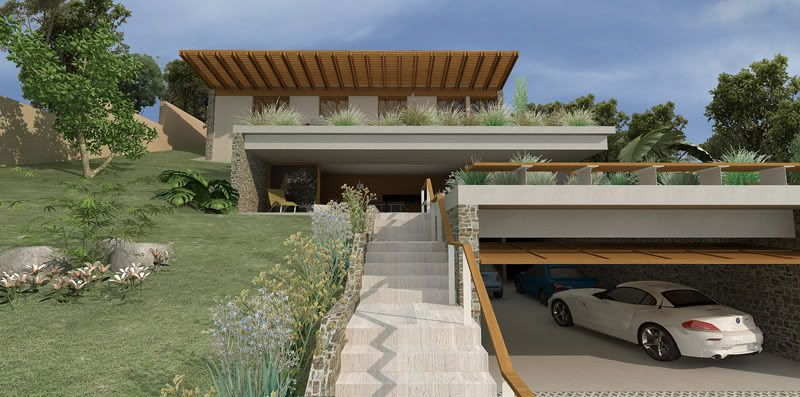


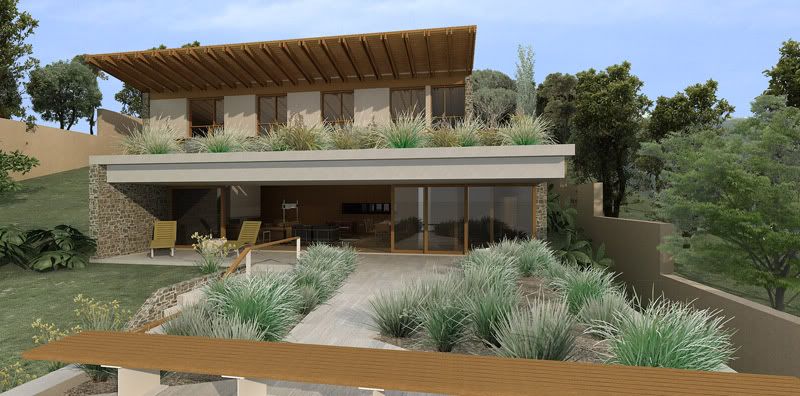
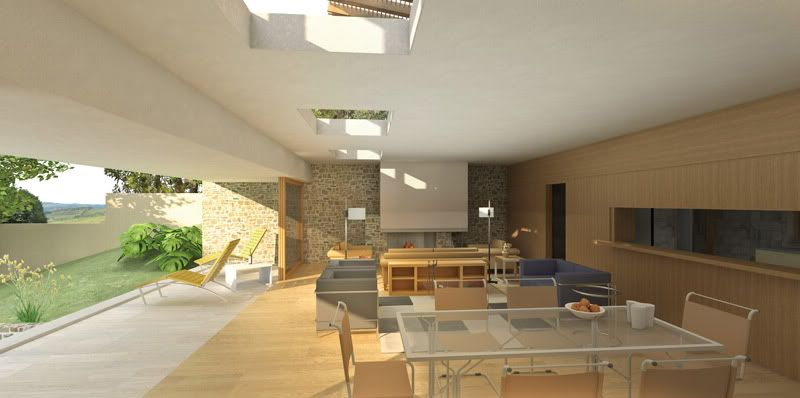
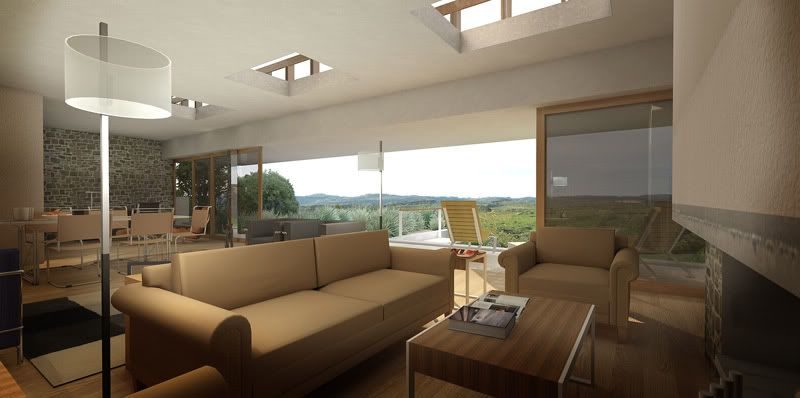
-
Bravo.
-
Good render but I prefer big focal lenght such as 125mm; probably the focal lenght of your camera is almost 28mm...so the result is an unreal visual perception;just only a curiosity: isn't possible(and usefull)to use the lateral ground by natural stone terrace?
-
@fabiorossi said:
Good render but I prefer big focal lenght such as 125mm; probably the focal lenght of your camera is almost 28mm...so the result is an unreal visual perception;just only a curiosity: isn't possible(and usefull)to use the lateral ground by natural stone terrace?
fabio,
thanks for commenting but i do not really understand what you mean. which image do you refer to? there was no choice of focal length, SU does not offer this. what is lateral ground? why stone terrace? sorry, but it seems we ran into a language problem here.besides, I am an architect not an archviz artist so total accuracy is not what I am after. what I want is to get an idea across. sorry if I disappoint you.
-
likes this...

-
I like the first image, it looks real...
allanx
-
@unknownuser said:
I prefer big focal lenght such as 125mm; probably the focal lenght of your camera is almost 28mm
Edson. Could Fabio be referring to the Camera Menu>Field of View selection that lets you enter the values in the lower right corner of SU, either in degrees, or mm as in 28mm. That sets your view to the same as a 28mm lens on a camera? I was looking for a way to convert FoV degrees to millimeters since I'm a photographer and don't think in degrees, when I discovered that SU does it for you my just putting mm after the value.
I like the wide angle look in your renderings, but I can see Fabio's point.
@unknownuser said:
isn't possible(and usefull)to use the lateral ground by natural stone terrace?
I'd be interested to know what he is referring to there also.
I'm posting my "first ever model" tonight. I've quit a way to go before I can do the remarkable work you have done.
Thank you for posting those pictures
Lloyd
-
@edson said:
@fabiorossi said:
Good render but I prefer big focal lenght such as 125mm; probably the focal lenght of your camera is almost 28mm...so the result is an unreal visual perception;just only a curiosity: isn't possible(and usefull)to use the lateral ground by natural stone terrace?
fabio,
thanks for commenting but i do not really understand what you mean. which image do you refer to? there was no choice of focal length, SU does not offer this. what is lateral ground? why stone terrace? sorry, but it seems we ran into a language problem here.besides, I am an architect not an archviz artist so total accuracy is not what I am after. what I want is to get an idea across. sorry if I disappoint you.
Usually the camera focal lenght is possible to set by the render engine;
stone terrace refers to outside accomodation of the ground instead of having a sloping site( it's only a my idea becouse I am also an architect)
-
Hi, Edson:
Excellent Design, Excellent site, Excellent imagery. -
@fabiorossi said:
Usually the camera focal lenght is possible to set by the render engine;
stone terrace refers to outside accomodation of the ground instead of having a sloping site( it's only a my idea becouse I am also an architect)
fabio,
thanks for clearing this up. now I understood what you mean.the rendering engine I use (podium) does not allow me to do that. perhaps using the new plugin AdvancedCameraTools this will be possible to control from within SU.
I agree, the site could be manipulated into terraces. perhaps if the design goes ahead I will get to that.
-
@edson said:
@fabiorossi said:
Usually the camera focal lenght is possible to set by the render engine;
stone terrace refers to outside accomodation of the ground instead of having a sloping site( it's only a my idea becouse I am also an architect)
fabio,
thanks for clearing this up. now I understood what you mean.the rendering engine I use (podium) does not allow me to do that. perhaps using the new plugin AdvancedCameraTools this will be possible to control from within SU.
I agree, the site could be manipulated into terraces. perhaps if the design goes ahead I will get to that.
ok, good job Edson!
-
Love it!
-
Another beautiful project, Edson.
-
thanks, bryan and daniel.
-
I just would like to thank you guys –and especially fabio– for bringing the focal length issue to my attention. I began using a wider lens for my interiors and just completely forgot to change it back to normal for the exteriors. I am playing with different focal lengths now and hope the next project I post will have no problems in that respect.
-
I have been posting this info elsewhere, but it is worth repeating in regard to Fabio's posting. First of all lens focal length determines how much of a scene you see, but in no ways changes or distorts perspective. Perspective is changed as you change viewer to subject distance. If we had infinitely detailed sensors or film available to us lens makers would almost be put out of business as no one would need more than one lens. You could just crop into your photo until you get the telephoto effect that you desire. To get telephoto effect you move away from your subject and to get wide angle effect you move close to your subject. The lens selection just gives us the cropping we want.
Take a wide angle shot and a telephoto shot from the same view point (same distance from subject). Then enlarge the subject in the wide angle shot to the same size as the telephoto shot and they can be laid over each other with perfect point-to-point correspondence.
In 35mm and DSLR cameras with 35mm full frame sensors the 55mm lens is considered "normal" but the definition of normal is a bit tricky. What normal means in this context is two eyed binocular vision where we have reasonably decent shape recognition maybe a 35 degree cone of vision. In reality we can see just a bit less than 180 degrees horizontally if we refer to the blurry extremes where we first sense motion but are unsure of shape of color. That sort of peripheral sensing is what kept our ancestors from being eaten by saber-tooth tigers or crushed by drunk drivers. At a 35 degree field of vision, things seem sharp and we have a good idea of shape. So we can call this normal but it is not actually that simple.
What I will ask you to do next is very difficult to do without cheating your own perception. Stare fixedly at the screen before you without moving your head and even harder don't move your eyes. In fact close one eye, because your camera only has one eye. Now with not even the slightest head or eye movement stare at the a five to eight letter word in the middle of the screen and you will notice that this is all you can see sharply without head or eye motion. This represents about a 12 to 15 degree field of vision which is a lot closer to the 120mm lens Fabio recommends if he is talking about 35mm photography. The reason we can accept a 55mm lens as normal is that we always move both our heads and eyes and that tricky little brain of ours takes a thousand little perceptions of sharpness and stitches them together for us.
A photograph is a fixed slice of time. Our perceptions of both reality and a photograph are a composite image formed over a some what extended time. Our perceptions are not of an instant but we remember an illusion built over an extended duration. That is why we can call a photo sharp although we NEVER saw the whole photo sharply at any single point in time. To begin to understand vision we must deconstruct the illusion we see as reality.
Now if have not sent you all screaming for the exits or simply put you to sleep let me digress for a moment on the subject of 3D. When I talk about 3D I am only referring to stereoscopic vision not motion parallax, or distance perceived because of atmospheric haze etc. (there are about 12 distance indicators). People who make 3D movies have found our sense of 3d space caused by the convergence of our eyes works best when the two stereo camera lenses are about 1/10th the distance from camera to subject. One day, I was studying some artistic anatomy books and noted that the distance between the center of our eyes is about 1/10 the distance from our eyes to our had at the end of an extended arm. Within that distance the angle that our eyes converge on an object increases rapidly and beyond our hand eye convergence decreases rapidly. Then the sense of of the whole thing hit me. The only place we need to control fine motor skills is within arms reach, that is the only place we create physical things with our hands, that is the only place we grab food, that is where we make the last ditch effort to protect ourselves. So humans forward facing eyes and the distance between them are closely related to intelligent tool making and the length of our reach.
The more we learn about perception the more we can control the perception of our art. So that is my visual rant for the night.
-
How did I get on this subject? Oh, yes lens selection. You can use any lens you want as long as you are aware and in agreement with how it will affect your audience's perception. Will your selection support the illusion you wish to create? If it supports your goal, you have done the right thing.
-
roger,
thanks for taking the time to enlighten us. very interesting subject indeed.

-
There are some very helpful comments here.
Still this is an absolutely beautiful project. Thank you for sharing this work, this is exactly the type of design work I want to do.
Brilliant work Edson. -
@cheffey said:
There are some very helpful comments here.
Still this is an absolutely beautiful project. Thank you for sharing this work, this is exactly the type of design work I want to do.
Brilliant work Edson.thanks, cheffey. you are very kind. I am really glad my work was liked by some of you in spite of obvious cultural differences.
Advertisement







